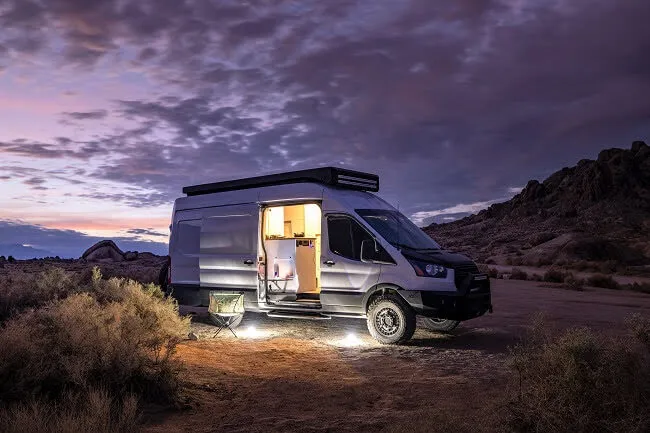Whether you’re a weekend explorer or planning a full-time nomadic lifestyle, the van you choose plays a crucial role in your experience. Among all the available options, the Ford Transit stands out as the perfect base vehicle for a camper van conversion. Known for its reliability, interior space, and ease of customization, the Ford Transit has quickly become a favorite in the van life community. If you’re considering professional help with your build, The Vansmith’s Ford Transit camper van conversions showcase expertly crafted layouts designed to suit a variety of lifestyles and needs.”
In this guide, we’ll break down why the Ford Transit is the ideal choice, offer a step-by-step conversion roadmap, and answer frequently asked questions to help you get started.
Why Choose a Ford Transit for Your Camper Conversion?
1. Spacious Interior with Multiple Sizes
The Ford Transit is available in various lengths and roof heights:
- Low Roof (4.96 ft interior height)
- Medium Roof (5.78 ft interior height)
- High Roof (6.77 ft interior height)
The high roof model allows most people to stand upright inside, a game-changer for long-term comfort. With extended versions like the Transit 148 Extended, you can build in a full bed, kitchen, and workspace without sacrificing room.
2. Modern Driving Experience
Unlike older vans like the Chevy Express or even the Sprinter (which often come with a hefty repair bill), the Ford Transit drives more like an SUV. With responsive handling, solid suspension, and available AWD (All-Wheel Drive) in newer models, it’s perfect for city drives, highways, and mild off-road adventures.
3. More Affordable Than Sprinter Vans
The Mercedes Sprinter is another favorite, but it comes with a steep price tag for both purchase and repairs. Ford Transits, especially used ones, offer great value and parts are readily available across the U.S., making repairs cheaper and quicker.
4. High Customizability
The boxy interior makes it easy to add modular furniture, electrical systems, insulation, and plumbing. It’s a blank canvas waiting to be turned into your dream mobile home.
Step-by-Step Guide: Converting a Ford Transit Into a Camper Van
Converting a Ford Transit may sound like a big task, but it becomes manageable when you break it down into phases. Here’s a detailed roadmap to guide your DIY journey.
Step 1: Choose the Right Ford Transit
Before you start, decide on:
- Roof height: High roof for full standing room.
- Length: Regular, long, or extended wheelbase.
- Drive type: AWD for more terrain versatility.
- Used vs. New: A used van can save thousands and still be reliable.
📌 Tip: Look for vans with under 100,000 miles and no history of rust or frame damage.
Step 2: Clean, Gut, and Prep the Interior
Strip everything inside the van like seats, panels, old insulation. Thoroughly clean the interior and check for any damage or rust.
Tools You’ll Need:
- Screwdrivers and socket wrench set
- Wire brush (for rust)
- Cleaning supplies
- Rust prevention spray or primer
Step 3: Plan the Layout
Sketch your ideal layout before building anything. Consider:
- Bed position (fixed vs. convertible)
- Kitchen and sink location
- Storage areas
- Toilet or shower
- Electrical and water system placement
Popular Layouts:
- Bed in the rear, kitchen in the middle, swivel seats up front.
- Side-to-side bed (only works for people under 6 feet, unless flares are added).
Need layout inspiration? Check out The Vansmith’s sample Transit conversion van layouts and designs to see what’s possible before sketching your own.
Step 4: Install Insulation and Soundproofing
Stay cool in summer and warm in winter by insulating your van.
Recommended Materials:
- Thinsulate or Sheep’s Wool (non-toxic and effective)
- Reflectix or foam board for windows and walls
- Sound-deadening mats like Kilmat or Noico
📌 Don’t skip this step. Proper insulation makes a massive difference in comfort.
Step 5: Electrical System
Design a basic solar and battery system:
- Battery bank (lithium recommended)
- Solar panels (typically 200W–400W)
- Inverter (for 120V appliances)
- DC-DC charger (to charge from the alternator)
Add outlets, LED lights, a fridge, and a fan. Pre-plan wiring paths before wall paneling.
Step 6: Flooring and Wall Paneling
Install:
- A subfloor (plywood) with insulation beneath
- Durable flooring like vinyl or laminate
- Wood or shiplap walls for aesthetics
Make sure everything is sealed properly to avoid moisture build-up.
Step 7: Furniture and Fixtures
Now it’s time to build:
- Bed frame (platform or convertible)
- Kitchen unit with stove, sink, and counter
- Storage drawers, overhead cabinets
- Water system with a fresh and grey tank, pump, and faucet
You can either DIY with plywood or buy modular systems from van build companies.
Step 8: Final Touches
- Add blackout curtains or window covers
- Decorate with plants, wall hangings, or LED lights
- Install a swivel seat base for more interior space
- Add ventilation via a Maxxair fan or roof vent
Who Should Consider a Ford Transit Conversion?
- First-time vanlifers who want an affordable and manageable project
- Weekend campers who want occasional adventure with home comfort
- Remote workers looking for a mobile office with solar power and Wi-Fi
- Couples or solo travelers who need moderate space and high reliability
Ford Transit Van Conversion: Pros and Cons
| Pros | Cons |
| Spacious and tall interior | Not as fuel-efficient as smaller vans |
| Affordable parts and service | Interior width slightly less than Promaster |
| AWD option for off-grid travel | May require roof rack for extra gear |
| Easy to drive and maneuver | Limited 4×4 options compared to Sprinter |
FAQs About Ford Transit Camper Vans
1. Is a Ford Transit big enough for full-time van life?
Yes. The High Roof Extended version offers enough space for a bed, kitchen, storage, and even a small bathroom.
2. Can you stand up inside a Ford Transit?
Yes, if you get the High Roof model. The high roof offers over 6’6″ of interior height.
3. How much does it cost to convert a Ford Transit?
A DIY conversion can cost $10,000–$25,000, depending on materials, features, and tools. Hiring a professional builder can range from $40,000 to $100,000+.
4. Is AWD worth it for a camper van?
If you plan on driving through snow, sand, or forest roads, AWD is a great investment. Otherwise, a rear-wheel-drive Transit can still handle light off-road conditions.
5. Can I finance a Ford Transit and still convert it?
Yes, many people finance the vehicle and use savings or personal loans for the conversion. Be sure to check if any vehicle modifications void warranties.
6. What’s better: Ford Transit or Ram Promaster?
Both have pros:
- Transit: Taller roof, better handling, AWD option
- Promaster: Wider interior, easier to build side-to-side bed
If height matters more, go with the Transit. If width matters more, the Promaster may be your pick. Just remember no AWD in the ProMaster
7. Can I hire someone to convert a Ford Transit?
Yes! Many people choose professionals to handle complex builds. The Vansmith offers custom Ford Transit conversions tailored to your preferences.
Final Thoughts
A Ford Transit conversion van is the ideal starting point for anyone entering the van life lifestyle. With multiple size options, reliability, and a spacious interior, it balances comfort, functionality, and affordability better than most alternatives on the market.
Whether you’re heading for the mountains, working remotely from national parks, or just escaping the city on weekends, the Transit provides a versatile, mobile home base ready to be customized your way.





























